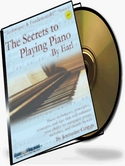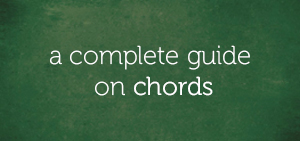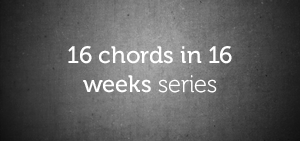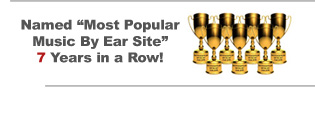|
Welcome to this latest newsletter on how to use simple patterns to learn all of your favorite worship songs by ear! You might want to print this lesson out because I reveal tons of information below that you won’t find anywhere else … literally!
Ask anyone who learns new songs regularly and they will tell you that the whole process is not about learning new chords or making new discoveries all the time. Why? Simply because chords, progressions, and changes are recycled over and over again in song after song. To know patterns is to know hundreds of songs, whether you realize it or not!
I’m talking about patterns like these:
1-4 patterns … 1-6 patterns … 2-5 patterns … 3-6 patterns … 3-4 patterns … and the list goes on and on. (Don’t worry if you don’t know what these numbers mean. I will explain all of this to you in this month’s classroom lesson below).
You’ll find patterns like these in hundreds of slow worship songs. And you know what? They’re even found in jazz, r&b, and contemporary music as well! …And by the way, all of this is in the GospelKeysTM 202 video course, which has helped countless numbers of musicians play gospel worship by ear!
———–
In this month’s online classroom, I’m going to share with you a few concepts from the GospelKeysTM 202 video course. I warn you beforehand! You probably have never seen anything quite like this before because there’s not a lot of information out there for worship and praise music.
What will be covered in Gk202 is the whole concept of “coupling.”
A “couple,” as described in the course, is basically a 2-part chord progression. It consists of one chord pulling very aggressively to another chord. You saw them above as you were reading about what the GospelKeysTM 202 will teach you. They look like this:
1-2, 1-3, 1-4,
1-5, 1-6, 1-7,
2-5, 2-6, 3-6,
3-4, 4-5, 4-3,
4-6, 4-7, 5-1,
5-2, 5-4, 6-2,
6-7, 7-3, etc.
… and these are some of the many examples of what I call “couples.”
Songs are built on progressions like these. Now most of you understand progressions like “2-5-1,” “6-2-5-1,” and “7-3-6-2-5-1” and I’ve even covered them throughout the year in past newsletters. Click here if you haven’t read my newsletters from January 04 – July 04.
“Couples” create these larger progressions. For example, a “2-5-1” is made up of two small couples:
A “2-5” couple and a “5-1” couple.
Another example would be a “6-2-5-1” progressions, which is very common in gospel praise songs and even in slower tunes. This larger progressions has three smaller couples within it:
A “6-2”, “2-5”, and “5-1” couple.
So by using smaller couples to create larger progressions, the process will not only seem less intimidating but your ear will catch on a lot faster. It’s a lot easier to calculate 2×2 and 3×3, and then add up the resulting numbers, right? 2 x 2 is 4 … and 3×3 is 9. Add them together and you get 13.
Learning couples is the same way. You’ll learn how to recognize “2-5” couples in songs … “5-1” couples in songs … and “6-2” couples in songs. Then, when necessary, you’ll have to combine “2-5” couples with “5-1” couples to create famous “2-5-1” progressions. It’s really a simple process and once you get it, you’ll be able to play not only worship songs but all types of songs in different genres (jazz, r&b, blues, pop, etc.).
Ok… if you’re new, then you might wonder: “Where do the numbers come from?”
I’m glad you asked.
Very simply, the numbers come from the major scale of whatever key you’re playing in. So, yes, there are “2-5” couples for every key — “5-1” couples for every key — and many many more!
Let’s say you’re in the key of Db major.
First, you would have to know the Db major scale.
Db major scale: Db Eb F Gb Ab Bb C Db
But memorizing scales alone will not allow you to play by ear. You have to understand the grand scheme of things. The scales provide the numbers and that’s what you need to understand with your eyes closed.
Db = 1
Eb = 2
F = 3
Gb = 4
Ab = 5
Bb = 6
C = 7
Db = 8 (same as 1)
… Now here is where people go wrong:
They learn the scales. They memorize them but they do not know them by numbers! When I say “to know a scale by numbers,” that means that you must know what is the “6” of Db within three seconds … or the “5” of Db … or the “2” of Db.
See… you don’t want to know the “6” of Db by having to start at Db and say the major scale, one note at a time, because when you are doing it that way, you aren’t learning the notes and numbers independent of each other.
It’s like not knowing what’s after “J” in the alphabet without having to sing your “ABC’s” from the beginning. You don’t want to know what comes after “J” by having to sing the entire song from the beginning. That’s what slows you down. Playing by ear is all about thinking on your feet and if you can’t think on your feet (with the method I just shared above), then you’ll struggle time and time again.
YOU HAVE TO GET TO THE POINT WHERE YOU KNOW THE NUMBERS WITHOUT HAVING TO RECITE THE MAJOR SCALE.
Ok… let’s take a quick mental test:
If you know your major scales forwards and backwards but can’t answer these questions within 3 seconds, then you still have work to do!
Question #1:
What’s the “2” of Ab major? ________
Question #2:
What’s the “7” of G major? ________
Question #3:
What’s the “5” of D major? ________
Question #4:
What’s the “3” of Eb major? _______
Question #5:
What’s the “1” of A major? ________ (you have to know this one within 3 sec!)
Question #6:
What’s the “6” of Db major? _______
Question #7:
What’s the “2” of B major? _______
ANSWERS: (Bb, F#, A, G, A, Bb, C#)
Once you’ve mastered your scales in this way, the concept of “couples” will appear very easy.
For example, here’s the keynotes of a “2-5” couple in multiple keys.
C major: D to G
F major: G to C
Bb major: C to F
Eb major: F to Bb
Ab major: Bb to Eb
Moving On…
Now that you know where the numbers come from, it should be easy to make sense of what the following couples are: A “1-2” couple means a chord based on the 1st tone of the scale leading to a chord based on the 2nd tone of the same scale. An example in the key of Db would be: Dbmaj9 to Eb9. The Dbmaj9 is a “1” chord because “Db” is the 1st tone of the scale and the Eb9 is a “2” chord because “Eb” is the 2nd tone of the scale. A “1-3” couple means a chord based on the 1st tone of the scale leading to a chord based on the 3rd tone of the same scale. An example in the key of Db would be: Dbmaj7 to F7 (b9). The Dbmaj9 is a “1” chord because “Db” is the 1st tone of the scale and the F7(b9) is a “3” chord because “F” is the 3rd tone of the scale. Other couples based on the “1” chord: 1-4, 1-5, 1-6, 1-7 A “2-5” couple means a chord based on the 2nd tone of the scale leading to a chord based on the 5th tone of the same scale. An example in the key of Db would be: Eb9 to Ab13. The Eb9 is a “2” chord because “Eb” is the 2nd tone of the scale and the Ab13 is a “5” chord because “Ab” is the 5th tone of the scale. Other couples based on the “2” chord: 2-3, 2-6, 2-7 … And the list goes on and on: 3-4, 4-5, 4-3, 4-6, 4-7, 5-1, 5-2, 5-4, 6-2, 6-7, 7-3, etc.
Putting It All Together… Basically the first hour of GospelKeysTM 202 is aimed at teaching you different chords for every tone of the major scale.
So, in essence, you’ll learn tons of:
“1” chords “2” chords “3” chords “4” chords “5” chords “6” chords “7” chords
For this online classroom lesson, I will give you a sneak-peak of the GospelKeysTM 202 video course by showing you some chords from each tone of the scale. Then after you’ve learned each chord, I will show you how to couple them together to create progressions, which will then create songs! It’s that easy!
Key of Db Major: Scale: Db – Eb – F – Gb – Ab – Bb – C – Db #’s: 1 2 3 4 5 6 7 8
An Example of a “1” chord: Db on left hand / Bb + Eb + Ab on right hand
An Example of a “2” chord: Eb on left hand / G + C + Db + F on right hand
An Example of a “3” chord: F on left hand / A + Db + Eb + Ab on right hand
An Example of a “4” chord: Gb on left hand / F + Bb + Db on right hand
An Example of a “5” chord: Ab on left hand / Gb + Bb + Db + F on right hand
An Example of a “6” chord: Bb on left hand / Ab + C + Db + F on right hand
An Example of a “7” chord: C on left hand / Eb + G + Bb + D
* Keep in mind that you will learn several chords for each tone of the scale. Because I have limited space in this e-mail newsletter, I have only included one chord per scale tone. The GospelKeysTM 202 video course will have several.
The second hour of the GospelKeysTM 202 video course covers “coupling.” This is where you’d actually take chords from each tone of the scale and combine them together to make small couples. Try doing this with the list above.
Take the “1” chord and “3” chord and play them one after the other. Then take that same “3” chord above, add the “6” chord, and play them one after the other.
In this example, you’ve just played a “1-3” couple followed by a “3-6” couple. Since the “3” chords are the same in both couples, if you were to play a “1-3” to a “3-6,” you wouldn’t have to repeat the “3” since you’re already playing it.
So in essence, when you combine the two smaller couples (which are easier to recognize in songs than huge progressions), you get a “1-3-6” progression.
That same “1-3-6” progression is used to begin “Thank You Lord”, “I Really Love the Lord,” “Silver and Gold” by Kirk Franklin, “Like the Dew in the Morning,” “Trouble Don’t Last Always,” and a host of other ones! I could literally go on and on and on…
Explore these chord types to prepare for the GospelKeys video course:
Well, I hope you enjoyed my newsletter and I’ll be back next time! Take care! If you were intrigued by the online classroom lesson above, then you would definitely benefit from my course!*** “The Secrets to Playing Piano By Ear” 300-pg Course *** With 20 chapters and over 300 pages, the home piano course provides several resources, techniques, tips, principles, and theories to playing the piano by ear. Along with hundreds of chords and scales, you’ll also learn how to turn them into gospel, jazz and blues chord progressions and better yet, how to use them to play ABSOLUTELY any song you want … IN VIRTUALLY MINUTES! Again, don’t miss this opportunity. I’ve even added an additional bonus if you purchase the course this week — You can read more about the course at: https://www.hearandplay.com/course
Enjoy this edition? Visit our message board and let us know! https://www.hearandplay.com/board Please Let a friend know about HearandPlay.com! PLEASE FORWARD THIS NEWSLETTER TO YOUR ENTIRE E-MAIL ADDRESS BOOK.
Yours Truly, Jermaine Griggs www.HearandPlay.com www.GospelKeys.com
Newsletter Archive – Click here or visit https://www.hearandplay.com/newsletters.html
|
Using Amazingly Simple Patterns to Learn Contemporary Worship Songs
The following two tabs change content below.

Founder at HearandPlay.com
Hi, I'm Jermaine Griggs, founder of this site. We teach people how to express themselves through the language of music. Just as you talk and listen freely, music can be enjoyed and played in the same way... if you know the rules of the "language!" I started this site at 17 years old in August 2000 and more than a decade later, we've helped literally millions of musicians along the way. Enjoy!
Previous post: Effectively Practicing with Circle of Fifths Patterns
Next post: 10 Video Lessons On Mastering Worship Chords



 “The Secrets to Playing Piano By Ear”
“The Secrets to Playing Piano By Ear” 



Comments on this entry are closed.